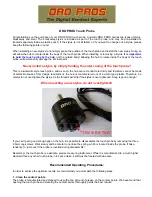
Service and Repairs
General Precautions for Removing and Installing Hydraulic System Components
Before Repair or Replacement of Components
1. Before removing any parts from the hydraulic sys-
tem, empty sweeper hopper and position sweeper on a
level surface. Chock sweeper wheels to prevent sweep-
er from moving. If sweeper is attached to tow vehicle,
engage tow vehicle parking brake, stop engine and re-
move key from the ignition switch.
2. Clean machine before disconnecting, removing or
disassembling any hydraulic components. Make sure
hydraulic components, hoses, connections and fittings
are cleaned thoroughly. Always keep in mind the need
for cleanliness when working on hydraulic equipment.
CAUTION
Operate all sweeper hydraulic controls to relieve
system pressure and to avoid injury from pres-
surized hydraulic oil. See Relieving Hydraulic
System Pressure in the General Information sec-
tion of this chapter.
3. Put caps or plugs on any hydraulic lines, hydraulic fit-
tings or hydraulic components left open or exposed to
prevent hydraulic system contamination.
4. Put labels on disconnected hydraulic lines and
hoses for proper installation after repairs are completed.
5. Note the position of hydraulic fittings (especially el-
bow fittings) on hydraulic components before removal.
Mark parts if necessary to make sure they will be aligned
properly when reinstalling hydraulic hoses and tubes.
After Repair or Replacement of Components
1. If component failure was severe or if hydraulic sys-
tem is contaminated, drain entire hydraulic system.
Drain and flush all hoses and components. Also, drain
and refill tow vehicle hydraulic system reservoir and
change oil filter.
2. Lubricate o–rings and seals with clean hydraulic oil
before installing hydraulic components.
3. Make sure caps or plugs are removed from the hy-
draulic tubes, hydraulic fittings and components before
reconnecting.
4. Use proper tightening methods when installing hy-
draulic hoses and fittings (see Hydraulic Fitting Installa-
tion in the General Information section of this chapter).
5. After repairs are completed but before operating the
sweeper, check oil level in the hydraulic reservoir of the
tow vehicle and add correct oil if necessary.
6. After disconnecting or replacing any hydraulic com-
ponents, operate machine functions slowly until air is
out of system.
7. Check for hydraulic oil leaks. Shut off tow vehicle en-
gine and correct leaks if necessary. Check oil level in hy-
draulic reservoir and add correct oil if necessary.
Hydraulic System
Check Hydraulic Lines and Hoses
or nozzles that eject hydraulic fluid under high
jected into the skin, it must be surgically re-
WARNING
Keep body and hands away from pin hole leaks
pressure. Use paper or cardboard, not hands, to
search for leaks. Hydraulic fluid escaping under
pressure can have sufficient force to penetrate
the skin and cause serious injury. If fluid is in-
moved within a few hours by a doctor familiar
with this type of injury. Gangrene may result from
such an injury.
Check hydraulic lines and hoses daily for leaks, kinked
lines, loose mounting supports, wear, loose fittings,
weather deterioration and/or chemical deterioration.
Make all necessary repairs before operating sweeper.
Pro Sweep 5200
Page 3 – 13
Hydraulic System
Summary of Contents for Pro Sweep 5200
Page 2: ...This page is intentionally blank Pro Sweep 5200...
Page 4: ...This page is intentionally blank Pro Sweep 5200...
Page 10: ...This page is intentionally blank Safety Page 1 6 Pro Sweep 5200...
Page 28: ...This page is intentionally blank Hydraulic System Page 3 12 Pro Sweep 5200...
Page 33: ...Hydraulic System This page is intentionally blank Pro Sweep 5200 Page 3 17 Hydraulic System...
Page 42: ...This page is intentionally blank Hydraulic System Page 3 26 Pro Sweep 5200...
Page 54: ...This page is intentionally blank Electrical System Page 4 12 Pro Sweep 5200...
Page 70: ...This page is intentionally blank Electrical Diagrams Page 6 2 Pro Sweep 5200...
















































